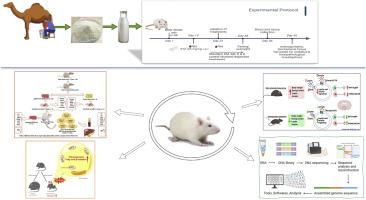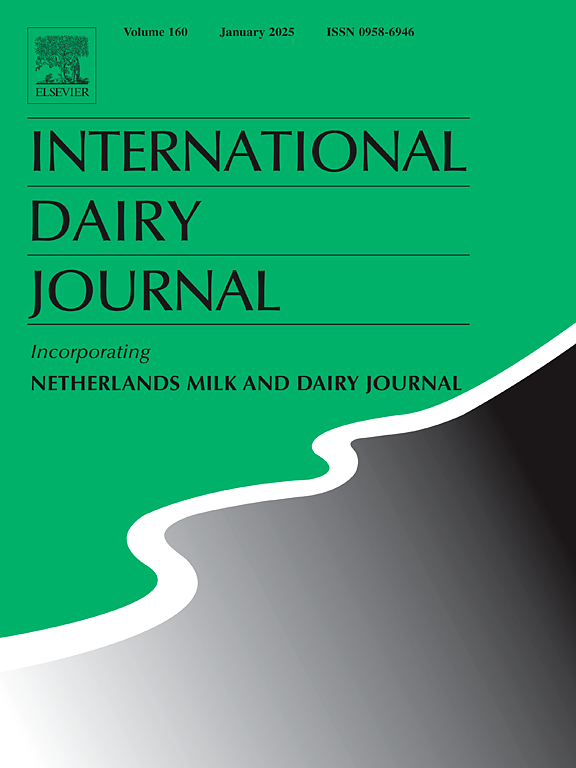喷雾干燥骆驼奶粉配方对高脂饮食诱导的ii型糖尿病Wistar大鼠生长性能、组织病理学和宏基因组研究的影响
IF 3.4
3区 农林科学
Q2 FOOD SCIENCE & TECHNOLOGY
引用次数: 0
摘要
本研究的目的是评估不同类型的喷雾干燥骆驼奶制剂对高脂肪饮食(HFD)诱导的II型糖尿病Wistar大鼠口服的抗糖尿病特性。与模型对照组(T-2)相比,标准药物(T-3)、巴氏奶(T-4)、灭菌奶(T-5)、奶粉(T-6)、腐乳(T-7)组的空腹血糖升高(分别为123.3±04.56、121.1±11.24、116.7±06.99、152.3±04.26和134.2±06.58 mg/dL)具有显著性(p < 0.0001)。与模型对照组(T-2)相比,除T-3外,各治疗组血糖水平均显著降低。模型对照组(T-2)葡萄糖峰值出现在30 ~ 60 min(356.4±12.74 mg/dL和368.4±11.38 mg/dL),显著高于对照组(T-1)(165.1±17.09 mg/dL和195.5±6.047 mg/dL) (p < 0.0001)。心脏组织病理学显示各组正常心肌细胞呈细长状和棒状。肝、心、肾、肠、胰等脏器均有病理改变,但无明显变化。不同组间α多样性差异不显著。然而,T-1组呈现的分类群数量多于其他处理组。元基因组分析的beta多样性测量揭示了样品之间的分类多样性。本研究结果表明,喂养2周的T-7通过改善血糖水平、胰岛素水平、血红蛋白A1c (HbA1c)水平和脂质谱,对II型糖尿病大鼠产生有益影响,表明其在未来治疗糖尿病方面具有潜在作用。本文章由计算机程序翻译,如有差异,请以英文原文为准。

Antidiabetic effect of spray dried camel milk powder formulations on the growth performance, histopathological and metagenomic investigation of high fat diet induced type-II diabetic Wistar rats
The aim of this investigation was to assess the antidiabetic characteristics of different types of spray-dried camel milk formulations administered orally to type II diabetic Wistar rats induced with a high-fat diet (HFD). Compared with the model control condition (T-2), treatment with the standard drug (T-3), pasteurized milk (T-4), sterilized milk (T-5), milk powder (T-6), or fermented curd (T-7) significantly (p < 0.0001) prevented the increase (123.3 ± 04.56, 121.1 ± 11.24, 116.7 ± 06.99, 152.3 ± 04.26 and 134.2 ± 06.58 mg/dL, respectively) in fasting blood glucose levels. Compared with those of the model control (T-2), the glucose levels of the treatment groups, with the exception of T-3, were significantly lower. The peak level of glucose in the model control group (T-2) was found at 30–60 min (356.4 ± 12.74 mg/dL and 368.4 ± 11.38 mg/dL), which was significantly (p < 0.0001) greater than that in the control group (T-1) (165.1 ± 17.09 mg/dL and 195.5 ± 6.047 mg/dL). Histopathology of the heart revealed normal cardiomyocytes that were elongated and rod shaped in all the groups. Pathological changes were observed in organs such as the liver, heart, kidney, intestine and pancreas but were not significant. The alpha diversity was not significantly different among the different groups. However, T-1 presented a greater number of taxa than did the other treatment groups. The beta diversity measure of the metagenomics analysis revealed the taxonomic diversity between the samples. The results of the present study indicated that T-7 fed for 2 weeks exerted a beneficial effect on type II diabetic rats via improvements in glucose levels, insulin levels, hemoglobin A1c (HbA1c) levels, and lipid profiles, suggesting a potential role in the treatment of diabetes in the future.
求助全文
通过发布文献求助,成功后即可免费获取论文全文。
去求助
来源期刊

International Dairy Journal
工程技术-食品科技
CiteScore
6.50
自引率
9.70%
发文量
200
审稿时长
49 days
期刊介绍:
The International Dairy Journal publishes significant advancements in dairy science and technology in the form of research articles and critical reviews that are of relevance to the broader international dairy community. Within this scope, research on the science and technology of milk and dairy products and the nutritional and health aspects of dairy foods are included; the journal pays particular attention to applied research and its interface with the dairy industry.
The journal''s coverage includes the following, where directly applicable to dairy science and technology:
• Chemistry and physico-chemical properties of milk constituents
• Microbiology, food safety, enzymology, biotechnology
• Processing and engineering
• Emulsion science, food structure, and texture
• Raw material quality and effect on relevant products
• Flavour and off-flavour development
• Technological functionality and applications of dairy ingredients
• Sensory and consumer sciences
• Nutrition and substantiation of human health implications of milk components or dairy products
International Dairy Journal does not publish papers related to milk production, animal health and other aspects of on-farm milk production unless there is a clear relationship to dairy technology, human health or final product quality.
 求助内容:
求助内容: 应助结果提醒方式:
应助结果提醒方式:


